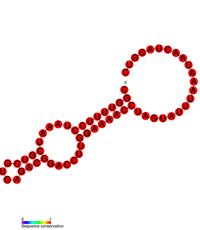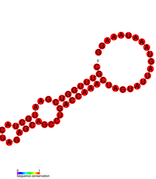Crinivirus
| Crinivirus | |
|---|---|
| Virus classification | |
| Group: | Group IV ((+)ssRNA) |
| Family: | Closteroviridae |
| Genus: | Crinivirus |
| Species | |
|
Abutilon yellows virus | |
| 3'-terminal pseudoknot in SPCSV | |
|---|---|
 | |
| Predicted secondary structure of the 3'-terminal pseudoknot in SPCSV | |
| Identifiers | |
| Symbol | ? |
| Rfam | RF01091 |
| Other data | |
| RNA type | Cis-reg |
| Domain(s) | Crinivirus |
Crinivirus is a genus of plant viruses that belong to the family Closteroviridae. They are also known as the lettuce infectious yellows virus group. They are linear, single-stranded positive sense RNA viruses (and are therefore group IV).[1]
Examples of species whose entire genomes have been sequenced that are currently classified into the genus include the Sweet potato chlorotic stunt virus (SPCSV) and the Lettuce infectious yellows virus (LIYV).[2][3]
Virus particle structure
The Universal Virus Database describes that the virions of the genus each consists of a non-enveloped, filamentous capsid "with a length of 1200–2000 nm and a width of 10-13 nm".[3] The capsid is also described to have "helical symmetry".
Genetics
The viruses of this genus have segmented, bipartite genomes that add up to 7,500–19,500 nucleotides in length. Their genomes also code for proteins that do not form part of the virion particles as well as structural proteins. The Universal Virus Database describes that their genome sequences near their 3'-ends are capable of hairpin-loop formation and also believe that their 5'-ends may have methylated caps.[3] Each of the viral RNA molecules contains four hair-pin structures and a pseudoknot in the 3'UTR. The pseudoknot is unusual in that it contains a small stem-loop structure inside loop L1.[4] In the related genus Closterovirus, these secondary structures have been found to be important in viral RNA replication.[5]
References
- ↑ ICTVdB Management (2006). 00.017.0.02. Crinivirus. In: ICTVdB—The Universal Virus Database, version 4. Büchen-Osmond, C. (Ed), Columbia University, New York, USA
- ↑ Journal of Virology. 2002 September; 76(18): 9260–9270
- ↑ 3.0 3.1 3.2 ICTVdB Management (2006)
- ↑ Livieratos IC, Eliasco E, Müller G et al. (July 2004). "Analysis of the RNA of Potato yellow vein virus: evidence for a tripartite genome and conserved 3'-terminal structures among members of the genus Crinivirus". J. Gen. Virol. 85 (Pt 7): 2065–75. doi:10.1099/vir.0.79910-0. PMID 15218192.
- ↑ Satyanarayana T, Gowda S, Ayllón MA, Albiach-Martí MR, Dawson WO (August 2002). "Mutational analysis of the replication signals in the 3'-nontranslated region of citrus tristeza virus". Virology 300 (1): 140–52. doi:10.1006/viro.2002.1550. PMID 12202214.
External links
- Viralzone: Crinivirus
- Rfam entry for 3'-terminal pseudoknot in SPCSV
- Rfam entry for 3'-terminal pseudoknot of CuYV/BPYV
- Rfam entry for 3'-terminal pseudoknot in PYVV
| |||||||||||||

